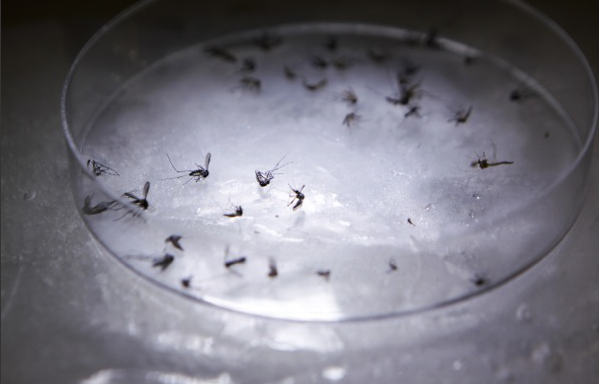Originally published October 10, 2014
By Nadia M. Whitehead
UTEP News Service
Marcela Diaz diligently brings a clear, plastic Tupperware to campus twice a week — but it isn’t for storing her lunch. At first glance the container actually appears empty, but look close enough and you’ll see tiny, dark insects gliding about within.
These are Diaz’s most recently trapped specimens: mosquitoes.
A member of the Mosquito Ecology and Surveillance Lab (MESL), Diaz sets and monitors mosquito traps at one of 12 sites within the city of El Paso. Her particular samples are caught near the corner of Lee Trevino and North Loop, but additional students and researchers place and collect traps in the Upper Valley, on the West side and even in Horizon.
MESL was established by University of Texas at El Paso researcher Douglas Watts, Ph.D., an expert on the blood-sucking pests and the viruses they transmit. Concerned about the mounting number of infections related to the insects — like chikungunya, West Nile and dengue — Watts created the center to identify and survey the various types of mosquitoes in the region and to test them for viruses.
“I think people underestimate mosquitoes,” Diaz said. “We know that they are annoying and that they bite us, but people generally don’t realize that there are different species and that they can transmit different things.”
While the mosquito species Aedes aegypti can carry chikungunya and dengue, Culex tarsalis and C. quinquiefasciatus can transmit West Nile and Saint Louis encephalitis. MESL has found each of these particular species living in El Paso, though they have yet to trap any that test positive as disease carriers.
But that doesn’t mean they aren’t out there, said lab director Cindy Crews. So far this year, 12 El Pasoans have contracted West Nile virus and she expects more cases to pop up before year’s end. Resurfacing viruses that have not been seen in decades are also a cause for concern.
“We’re in a particularly vulnerable spot along the border as the mosquitoes [that carry dengue and chikungunya] move north from Mexico,” said Crews, who specializes in mosquito ecology. Historically, A. aegypti have been widespread throughout South America and the southern U.S., but insect mitigation reduced their population and range. Now, they are reemerging at a significant rate, she said.
However, by vigorously surveying the region, she hopes MESL can help prevent mosquito-borne virus outbreaks.
After bringing in their “catch” on Wednesdays and Thursdays, the researchers immediately freeze the specimens. While the insects won’t survive, the cold temperature preserves any potential viruses they are carrying, Crews said.
After a couple of hours in the freezer, the lab begins to examine each and every mosquito. In search of females, which are the only ones that drink blood, first they identify the sex. Students have been taught to look for extremely hairy, or bushy antennae — the trademark of males. Female antennae have far less hair and the difference is quite noticeable under the microscope.
Then, students begin to narrow down the mosquito’s species. A. Aegypti are typically identified by their black and silver striped bodies, while C. tarsalis and C. quinquiefasciatus look similar with brown bodies and golden specks throughout. At the same time, the team examines the female’s abdomen to see if it has recently fed on blood. If so, the belly will appear bloated with a dark or bright red coloring. These blood-fed females are set apart and saved for UTEP’s Biosafety Level 3 laboratory for viral testing.
If a mosquito tests positive for any virus, the team can trace the sample back to the original El Paso location where it was trapped. “Knowing where they are located is a good way of knowing where you have to spray,” said Crews, explaining that mosquito populations usually stick to the same area.
The researchers can then alert the El Paso Department of Public Health and urge pest management in the specific area to stop the spread of the virus.
The laboratory is already collaborating with the city and multiple institutions in the tri-state area, including the Centers for Disease Control and Prevention and the Universidad Autonoma de Ciudad Juárez. Together, they have created the region’s emergency response plan in the event of an outbreak.
“This has been an awesome experience,” said Diaz, who is an El Paso Community College student who will soon transfer to UTEP through the Bridges to the Baccalaureate program. “When we had our first tri-state meeting, I saw all these different entities coming together from the whole region. It hit me that this is more than just lab work and trapping mosquitoes; this is for the good of the community.”
